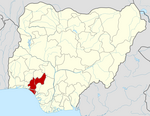Idanre
Idanre
Ùdànè Odode Idanre | |
|---|---|
Local Government Area and Town | |
 View of Idanre Town from Idanre Hill | |
 Idanre Location in Nigeria | |
| Coordinates: 7°05′32″N 5°07′56″E / 7.09222°N 5.13222°ECoordinates: 7°05′32″N 5°07′56″E / 7.09222°N 5.13222°E | |
| Country | |
| State | Ondo |
| Area | |
| • Land | 739 sq mi (1,914 km2) |
| Population (2006) | |
| • Total | 129,024 |
| Time zone | UTC+1 (WAT) |
Idanre is a Local Government Area and historic town in Ondo State, Nigeria. The town is located at the foot of the scenic Idanre Hill which is of unique cultural and environmental significance, and attracts many tourists.[1][2][3][4]
The town is about 20 km (12 mi) southeast of the state's capital Akure, it has an area of 1,914 km2 (739 sq mi) and a population of 129,024 as of the 2006 census.[5] The postal code of the area is 340.[6] Idanre is Nigeria's largest cocoa producing area.[7][8][9] Idanre is mainly a Yoruba speaking tribe (Similar Ondo Dialect) with the majority Into farming and trading.
Idanre controversially divided under three-leader Rule, is divided into three localities of Atosin, Alade, Odode (Ode-Idanre). Although Ode Idanre is set as the Major Township with vast Population and Land Area, the others has always been recognized by the inhabitants independently. Idanre major food is mixed okro soup and pounded yam (common in the state).
Idanre Hills[]
The Idanre Hill, or Oke Idanre is located in Idanre town in Ondo State of southwestern Nigeria.

Site description[]
The hill of Idanre is one of the most beautiful natural landscapes in Nigeria. It includes such cultural sites as "Owa's Palace, Shrines, Old Court, Belfry, Agbooogun footprint, thunder water (Omi Apaara) and burial mounds and grounds". It resides 3,000 ft (910 m) above sea level and houses a unique ecosystem upon which the cultural landscape has integrated. On getting to the entrance of the hill you will see a great tree at the entrance of the ancient city of Idanre called the IRAYE TREE, then you can now get prepared to take the steps to the great city beyond the hills of Idanre.
World Heritage status[]
This site was added to the UNESCO World Heritage Tentative List on October 8, 2007, in the Cultural category.
Wildlife[]
Amietophrynus perreti, or the Perret's toad, is only known from a single locality at the Idanre Hill. The five sites where forest elephants are found in southern Nigeria are the Omo Forests in Ogun State, the Okomu National Park in Edo State, the Cross River National Park in Cross River State, the IDANRE FORESTS and Osse River Park in Ondo State and the Andoni Island in Rivers State. [Nigerian Conservation Foundation (NCF) ]
References[]
- ^ "Idanre Hills: Tourists haven on its knees", Daily Independent, 13 July 2012, archived from the original on 4 March 2016, retrieved 5 November 2017
- ^ Oke Idanre (Idanre Hill) - UNESCO World Heritage Centre
- ^ Frost, Darrel R. (2015). "Amietophrynus perreti (Schiøtz, 1963)". Amphibian Species of the World: an Online Reference. Version 6.0. American Museum of Natural History. Retrieved 24 October 2015.
- ^ Onadeko, Abiodun B.; Rödel, Mark-Oliver; Liedtke, H. Christoph; Barej, Michael (2014). "The rediscovery of Perret's toad, Amietophrynus perreti (Schiøtz, 1963) after more than 40 years, with comments on the species' phylogenetic placement and conservation status". Zoosystematics and Evolution. 90 (2): 113–119. doi:10.3897/zse.90.8234.
- ^ "Idanre Hills, Ondo State". PacfNigeria. Archived from the original on 2014-10-31. Retrieved 2014-10-31.
- ^ "Post Offices- with map of LGA". NIPOST. Archived from the original on 7 October 2009. Retrieved 20 October 2009.
- ^ Frank H. Columbus (2001). Politics and Economics of Africa. Vol. 2. University of Virginia (Nova Science). ISBN 978-1-59-03327-88.
- ^ Africa Today. Vol. 33. Afro Media. 1997. p. 42.
- ^ Ibrahim Apekhade Yusuf (Lagos); Damisi Ojo (Akure); Ernest Nwokolo (Abeokuta); Adesoji Adeniyi (Osogbo) (April 14, 2013). "Cocoa: Once upon a cash crop". The Nation. Retrieved December 28, 2017.
- Local Government Areas in Ondo State
- Towns in Yorubaland
- Nigeria geography stubs


